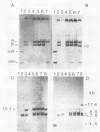Abstract
We have used triparental matings to demonstrate transfer (mobilization) of the nonconjugative genetically engineered plasmid pHSV106, which contains the thymidine kinase gene of herpes simplex virus cloned into pBR322, from Escherichia coli HB101 to an environmental isolate of Enterobacter cloacae in sterile drinking water. This is the first demonstration of a two-step mobilization of a genetically engineered plasmid in any type of fresh water, including drinking water. Transfer was mediated by R plasmid R100-1 of E. coli ED2149(R100-1). Matings in drinking water at 15, 25, and 35 degrees C yielded recombinants, the number of which increased with increasing temperature. Numbers of recombinants obtained were 2 orders of magnitude lower than those obtained from matings in Trypticase soy broth. High concentrations of parental organisms (2.6 x 10(8) to 2.0 x 10(9) CFU/ml) were required. During 1 week of incubation in drinking water, number of parental organisms and recombinants resulting from mobilization remained constant in the absence of indigenous organisms and declined in their presence. Using oligonucleotide probes for the cloned foreign DNA (thymidine kinase gene) and plasmid vector DNA (ampicillin resistance gene), we demonstrated that both genes were transferred to E. cloacae in the mobilization process. In one recombinant selected for detailed study, the plasmids containing these genes differed in size from all forms of pHSV106 present in E. coli HB101(pHSV106), indicating that DNA rearrangement had occurred. This recombinant maintained its plasmids in unchanged form for 15 days in drinking water. A second rearrangement occurred during serial passage of this recombinant on selective media.(ABSTRACT TRUNCATED AT 250 WORDS)
Full text
PDF






Images in this article
Selected References
These references are in PubMed. This may not be the complete list of references from this article.
- Amy P. S., Hiatt H. D. Survival and detection of bacteria in an aquatic environment. Appl Environ Microbiol. 1989 Apr;55(4):788–793. doi: 10.1128/aem.55.4.788-793.1989. [DOI] [PMC free article] [PubMed] [Google Scholar]
- Armstrong J. L., Shigeno D. S., Calomiris J. J., Seidler R. J. Antibiotic-resistant bacteria in drinking water. Appl Environ Microbiol. 1981 Aug;42(2):277–283. doi: 10.1128/aem.42.2.277-283.1981. [DOI] [PMC free article] [PubMed] [Google Scholar]
- Bale M. J., Fry J. C., Day M. J. Transfer and occurrence of large mercury resistance plasmids in river epilithon. Appl Environ Microbiol. 1988 Apr;54(4):972–978. doi: 10.1128/aem.54.4.972-978.1988. [DOI] [PMC free article] [PubMed] [Google Scholar]
- Bolivar F., Rodriguez R. L., Greene P. J., Betlach M. C., Heyneker H. L., Boyer H. W., Crosa J. H., Falkow S. Construction and characterization of new cloning vehicles. II. A multipurpose cloning system. Gene. 1977;2(2):95–113. [PubMed] [Google Scholar]
- Crisona N. J., Clark A. J. Increase in conjugational transmission frequency of nonconjugative plasmids. Science. 1977 Apr 8;196(4286):186–187. doi: 10.1126/science.322280. [DOI] [PubMed] [Google Scholar]
- Dempsey W. B., Willetts N. S. Plasmid co-integrates of prophage lambda and R factor R100. J Bacteriol. 1976 Apr;126(1):166–176. doi: 10.1128/jb.126.1.166-176.1976. [DOI] [PMC free article] [PubMed] [Google Scholar]
- Gealt M. A., Chai M. D., Alpert K. B., Boyer J. C. Transfer of plasmids pBR322 and pBR325 in wastewater from laboratory strains of Escherichia coli to bacteria indigenous to the waste disposal system. Appl Environ Microbiol. 1985 Apr;49(4):836–841. doi: 10.1128/aem.49.4.836-841.1985. [DOI] [PMC free article] [PubMed] [Google Scholar]
- Guyer M. S. The gamma delta sequence of F is an insertion sequence. J Mol Biol. 1978 Dec 15;126(3):347–365. doi: 10.1016/0022-2836(78)90045-1. [DOI] [PubMed] [Google Scholar]
- Kilbane J. J., Malamy M. H. F factor mobilization of non-conjugative chimeric plasmids in Escherichia coli: general mechanisms and a role for site-specific recA-independent recombination at orV1. J Mol Biol. 1980 Oct 15;143(1):73–93. doi: 10.1016/0022-2836(80)90125-4. [DOI] [PubMed] [Google Scholar]
- LeChevallier M. W., Babcock T. M., Lee R. G. Examination and characterization of distribution system biofilms. Appl Environ Microbiol. 1987 Dec;53(12):2714–2724. doi: 10.1128/aem.53.12.2714-2724.1987. [DOI] [PMC free article] [PubMed] [Google Scholar]
- McClure N. C., Weightman A. J., Fry J. C. Survival of Pseudomonas putida UWC1 containing cloned catabolic genes in a model activated-sludge unit. Appl Environ Microbiol. 1989 Oct;55(10):2627–2634. doi: 10.1128/aem.55.10.2627-2634.1989. [DOI] [PMC free article] [PubMed] [Google Scholar]
- McKnight S. L., Gavis E. R. Expression of the herpes thymidine kinase gene in Xenopus laevis oocytes: an assay for the study of deletion mutants constructed in vitro. Nucleic Acids Res. 1980 Dec 20;8(24):5931–5948. doi: 10.1093/nar/8.24.5931. [DOI] [PMC free article] [PubMed] [Google Scholar]
- O'Morchoe S. B., Ogunseitan O., Sayler G. S., Miller R. V. Conjugal transfer of R68.45 and FP5 between Pseudomonas aeruginosa strains in a freshwater environment. Appl Environ Microbiol. 1988 Aug;54(8):1923–1929. doi: 10.1128/aem.54.8.1923-1929.1988. [DOI] [PMC free article] [PubMed] [Google Scholar]
- Rafii F., Crawford D. L. Transfer of conjugative plasmids and mobilization of a nonconjugative plasmid between Streptomyces strains on agar and in soil. Appl Environ Microbiol. 1988 Jun;54(6):1334–1340. doi: 10.1128/aem.54.6.1334-1340.1988. [DOI] [PMC free article] [PubMed] [Google Scholar]
- Ridgway H. F., Olson B. H. Scanning electron microscope evidence for bacterial colonization of a drinking-water distribution system. Appl Environ Microbiol. 1981 Jan;41(1):274–287. doi: 10.1128/aem.41.1.274-287.1981. [DOI] [PMC free article] [PubMed] [Google Scholar]
- SUGINO Y., HIROTA Y. Conjugal fertility associated with resistance factor R in Escherichia coli. J Bacteriol. 1962 Nov;84:902–910. doi: 10.1128/jb.84.5.902-910.1962. [DOI] [PMC free article] [PubMed] [Google Scholar]
- Singleton P., Anson A. E. Conjugal transfer of R-plasmid R1drd-19 in Escherichia coli below 22 degrees C. Appl Environ Microbiol. 1981 Nov;42(5):789–791. doi: 10.1128/aem.42.5.789-791.1981. [DOI] [PMC free article] [PubMed] [Google Scholar]
- Trevors J. T., Oddie K. M. R-plasmid transfer in soil and water. Can J Microbiol. 1986 Jul;32(7):610–613. doi: 10.1139/m86-114. [DOI] [PubMed] [Google Scholar]
- Walmsley R. H. Temperature dependence of mating-pair formation in Escherichia coli. J Bacteriol. 1976 Apr;126(1):222–224. doi: 10.1128/jb.126.1.222-224.1976. [DOI] [PMC free article] [PubMed] [Google Scholar]
- Yoshioka Y., Ohtsubo H., Ohtsubo E. Repressor gene finO in plasmids R100 and F: constitutive transfer of plasmid F is caused by insertion of IS3 into F finO. J Bacteriol. 1987 Feb;169(2):619–623. doi: 10.1128/jb.169.2.619-623.1987. [DOI] [PMC free article] [PubMed] [Google Scholar]
- Young I. G., Poulis M. I. Conjugal transfer of cloning vectors derived from ColE1. Gene. 1978 Oct;4(2):175–179. doi: 10.1016/0378-1119(78)90029-x. [DOI] [PubMed] [Google Scholar]





